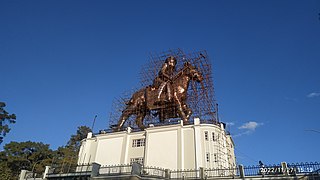Related Research Articles

Manipuri Vaishnavism, also known as Meitei Vaishnavism is a regional variant of Gaudiya Vaishnavism with a culture-forming role in the north-eastern Indian state of Manipur.

Manipur is home to a population playing many different sports.

Senbi Kiyamba (1467–1508) was a Meitei monarch and a ruler of Kangleipak kingdom. He was the son of Medingu Ningthou Khomba and his warrior queen Leima Linthoingambi. Born Thangwai Ningthouba, he succeeded his father at the age of 24. He took the name Kiyamba meaning "Conqueror of Kyang", after conquering the Shan kingdom in the Kabaw Valley in alliance with King Choupha Khe Khomba of Pong in 1470.
Hiyangthang is a town in Indian state of Manipur. It is best known for the Hiyangthang Lairembi Temple, a Meitei shrine dedicated to ancient Meitei goddess Irai Leima. It is located in Imphal West district.

Panthoibi, also known as Nongpok Leima, is a goddess associated with civilization, courage, fertility, handicraft, love, victory, warfare and wisdom in the mythology and religion of Ancient Kangleipak. She is a consort of the God Nongpok Ningthou. She is considered to be one of the divine incarnations of Leimarel Sidabi and is also identified as a form of Goddess Nongthang Leima. She is worshipped mainly by the Meitei people in Manipur, Assam, Tripura, Bangladesh and Myanmar.

Panthoibi Iratpa or Panthoibi Iraat Thouni or Panthoibi Eratpa is a religious festival of the Meitei people dedicated to Panthoibi, the ancient Meitei goddess of civilization, courage, fertility, handicraft, love, victory, warfare and wisdom of Sanamahism. It is celebrated on the first day of the Meitei lunar month of Mera, based on the traditional Meitei calendar. It usually, though not always, coincides with the day of the Hindu festival of Durga Puja, which is based on the Hindu calendar. So, both the festival are often celebrated together in Manipur, despite their religious differences. Goddess Panthoibi is syncretised with Hindu goddess Durga since 1714 AD during the reign of emperor Pamheiba when he made Hinduism as the official religion of the Kingdom of Manipur.

Irai Leima is a goddess in Sanamahism, the indigenous religion of Manipur. She is the goddess and the divine female personification of water and aquatic life. She is the consort of Irai Ningthou. Both are regarded as the divine spirits of water bodies. She is also considered to be in charge of diseases.

Nongpok Ningthou, also known as the Sovereign of the East or King of the East, is a deity in Sanamahism, the indigenous religion of Manipur. He is the ruling guardian deity of the eastern direction. Legend says Nongpok Ningthou and his consort Panthoibi were united in the Nongmaiching Ching mountains. Later, they were worshipped as the civilization giving deities in Meitei religion.

Khoriphaba is a God in Sanamahism, the indigenous religion of Manipur. He is the son of Sky God Salailen and the Goddess Konthoujam Tampha Lairembi. He came down from heaven to earth to search for his mother and then for a bride. He is best known for wrestling with Loyalakpa in the Lai Haraoba festival. He is also a Sagol Kangjei(polo)-playing God.

Dragons play a significant role in the legendary accounts of Meitei folklore, Meitei literature, Meitei mythology and Meitei religion (Sanamahism) of Ancient Kangleipak, Medieval Kangleipak and Modern Kangleipak.

Yumjao Leima or Yumjao Lairembi or Yumjao Lairemma is the mother goddess of house, household, royalty, rule and power in Meitei mythology and religion. She is designated as the all time ruling Queen Mother. Legend says she assumes a human form in white clothes and blesses kings. She is one of the divine incarnations of Leimarel Sidabi.

Khamlangba is a deity in Sanamahism, the indigenous religion of Manipur. He is the God of iron, mining, metallurgy, steel manufacturing, hunting and war. His occupation is the extraction of the iron ores and the manufacture of steel. The Khamlangba Thenlon text mentions about his skills of iron metallurgy and blacksmith in ancient Kakching kingdom.

Panam Ningthou is a God in Sanamahism, the indigenous religion of Manipur. He is the protector of crops, especially rice, from hailstorms and thunder. According to legends, He ignited the first fire with flint. He is one of the Umang Lai deities.

Thongak Lairembi, is a divine female personification of the death who guards the door of the entrance to the underworld.

Ichum Lairembi is a goddess in Sanamahism, the indigenous religion of Manipur. Her major cult centre of worship is located in Khurkhul.

In Meitei mythology and Sanamahism, the indigenous religion of Manipur, Kanglā shā is a sacred guardian beast with a lion's body and a two-horned dragon's head. It is a royal symbol of the Meitei royalties . The most remarkable statues dedicated to "Kangla Sa" stand inside the Kangla.
Ningthou Kangba was a ruler of Ancient Kangleipak. He is traditionally seen as having invented Sagol Kangjei, the earliest form of the modern day polo sports. He was the son of King Tangja Leela Pakhangba (1445 BC-1405 BC) and Queen Sinbee Leima. He was the consort of Queen Leima Taritnu, daughter of a king named Nongpok Ningthou of the Nongmaiching Hill in the east of Imphal.

Jagoi refers to the arts of dance in Meitei culture.
References
- 1 2 "Hiyangthang Lairembi Temple". Archived from the original on 25 January 2020. Retrieved 21 March 2021.
- 1 2 3 4 Lisam, Khomdan Singh (2011). Encyclopaedia Of Manipur (3 Vol.). Gyan Publishing House. p. 674. ISBN 978-81-7835-864-2.
- 1 2 Laishram, Ranbir (10 October 2016). "Hiyangthang Lairembi Temple on "Bor" | KanglaOnline" . Retrieved 15 June 2022.
- ↑ "Hiyangthang Lairembi Temple, Hiyangthang".
- ↑ "Durga Puja".
- 1 2 3 4 5 Lisam, Khomdan Singh (2011). Encyclopaedia Of Manipur (3 Vol.). Gyan Publishing House. p. 675. ISBN 978-81-7835-864-2.
- 1 2 3 4 Lisam, Khomdan Singh (2011). Encyclopaedia Of Manipur (3 Vol.). Gyan Publishing House. p. 676. ISBN 978-81-7835-864-2.
- 1 2 Noni, Arambam; Sanatomba, Kangujam (16 October 2015). Colonialism and Resistance: Society and State in Manipur. Routledge. ISBN 978-1-317-27066-9.